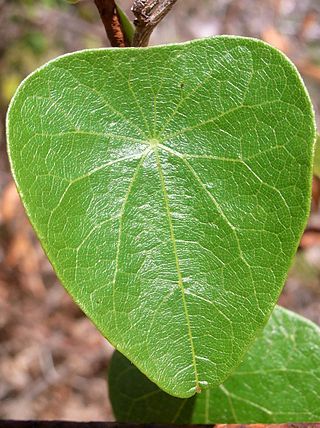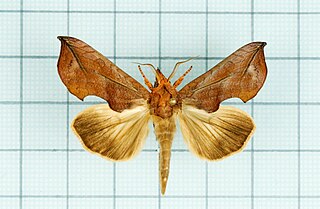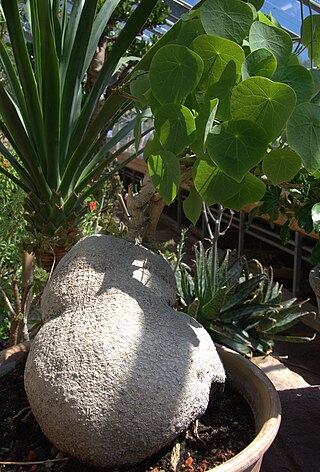
Boesenbergia rotunda, commonly known as Chinese keys, fingerroot, lesser galangal or Chinese ginger, is a medicinal and culinary herb from China and Southeast Asia. In English, the root has traditionally been called fingerroot, because the shape of the rhizome resembles that of fingers growing out of a center piece.

Menispermaceae is a family of flowering plants. The alkaloid tubocurarine, a neuromuscular blocker and the active ingredient in the 'tube curare' form of the dart poison curare, is derived from the South American liana Chondrodendron tomentosum. Several other South American genera belonging to the family have been used to prepare the 'pot' and 'calabash' forms of curare. The family contains 68 genera with some 440 species, which are distributed throughout low-lying tropical areas with some species present in temperate and arid regions.

Spondias is a genus of flowering plants in the cashew family, Anacardiaceae. The genus consists of 17 described species, 7 of which are native to the Neotropics and about 10 are native to tropical Asia. They are commonly named hog plums, Spanish plums, libas in Bikol and in some cases golden apples for their brightly colored fruit which resemble an apple or small plum at a casual glance. They are only distantly related to apple and plum trees, however. A more unequivocal common name is mombins.

Eucalyptus crebra, commonly known as the narrow-leaved ironbark, narrow-leaved red ironbark or simply ironbark, and as muggago in the indigenous Dharawal language, is a species of small to medium-sized tree endemic to eastern Australia. It has hard, rough "ironbark" from its trunk to small branches, linear to lance-shaped adult leaves, flower buds in groups of seven, nine or eleven, white flowers and cup-shaped, barrel-shaped or hemispherical fruit. A variable species, it grows in woodland and forest from the Cape York Peninsula to near Sydney. It is an important source of nectar in the honey industry and its hard, strong timber is used in construction.

Stephania is a genus of flowering plants in the family Menispermaceae, native to eastern and southern Asia and Australia. They are herbaceous perennial vines, growing to around four metres tall, with a large tuber. The leaves are arranged spirally on the stem and are peltate, with the leaf petiole attached near the centre of the leaf. The name Stephania comes from the Greek, "a crown". This refers to the anthers being arranged in a crown-like manner.
Stephania reticulata is a shrub native to Thailand, Malaysia and Indonesia described by Lewis Leonard Forman.

Stephania japonica, known as snake vine, is a vine often seen in sheltered areas near the sea.

Oraesia excavata is a species of moth of the family Erebidae first described by Arthur Gardiner Butler in 1878. It is found in Japan, Korea, China, Thailand and Taiwan and has recently been recorded from Hawaii.
Lewis Leonard Forman was a British botanist, born in London. He was an expert on spermatophytes, particularly Menispermaceae, and specialised in the plants of Southeast Asia. He graduated from the University of London in 1950 and was appointed to the staff of the Royal Botanic Gardens, Kew in 1951, serving as a senior official there from 1966 to 1989.
Stephania tomentella is a herbaceous perennial vine of the family Menispermaceae and genus Stephania. It is native to Southeast Asia and was first described in Thailand in 1988 by L. L. Forman. It is one of 15 Stephania found only in northern Thailand, specifically in the area around Chiang Rai. It has leaves measuring 7–9 cm (2.8–3.5 in) in both width and length. It is commonly found amongst limestone rocks.
Flora of Thailand is a multi-volume flora describing the vascular plants of Thailand, published by the Forest Herbarium, Royal Forest Department since the 1970s. It currently consists of 12 volumes.

Caladenia crebra, commonly known as the Arrowsmith spider orchid is a species of orchid endemic to the south-west of Western Australia. It has one or two relatively large, greenish-yellow flowers whose lateral sepals have thin brown "clubs" on their ends.
Pericampylus is a genus of flowering plants belonging to the family Menispermaceae.
Albertisia is a genus of flowering plants belonging to the family Menispermaceae.
Parapachygone is a monotypic genus of flowering plants belonging to the family Menispermaceae. The only species is Parapachygone longifolia.

Stephania suberosa is a shrub native to Thailand, described by Lewis Leonard Forman in 1980.
Stephania tuberosa is a plant in the family Menispermaceae which is endemic to Queensland. It grows as a vine with a stem diameter of up to 5 cm (2.0 in) and produces a distinctive large tuber on the ground which can be up to 50 cm (20 in) diameter.

Stephania kaweesakii is a herbaceous perennial vine in the genus Stephania of the family Menispermaceae. It is native to Southeast Asia and was first described in Thailand in 2020 by Thai botanists Thaya Jenjittikul and Saroj Ruchisansakun.
Stephania pierrei, also known as Stephania erecta or binh voi in Vietnamese, is a caudiciform vine native to the Indo-Chinese Peninsula. It is cultivated as a houseplant; in commerce it is typically described as Stephania erecta. It was first described by Ludwig Diels in 1910. The root or caudex is used medicinally in Vietnam; the 2006 Vietnam Red List of Medicinal Plants lists Stephania pierrei as a vulnerable species within the country.

Hypserpa laurina is a slender twining climber in the plant family Menispermaceae. It is native to New Guinea and north eastern Queensland in Australia.










